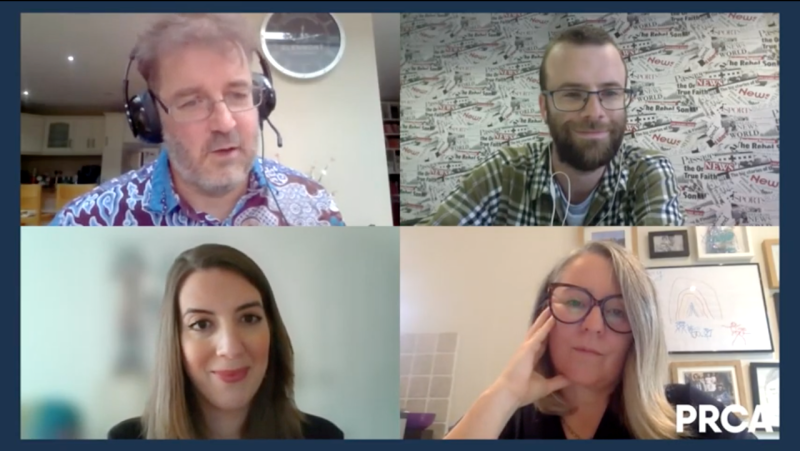
Using case studies and amplifying the voices of people with lived experience is a vital tool in the charity communications armoury - but it’s important to get it right, for the sake of everyone concerned.
I was delighted to chair the latest PRCA Charities & Not-For Profit Group, which tackled this subject with the help of three expert guests.
Our first guest, Mark Webb, head of comms at the charity Shift.ms, has a unique perspective on the topic having lived with Multiple Sclerosis for more than a quarter of a century and himself been a case study in campaigns including one for the We Are Undefeatable campaign earlier this year. You can hear more about his personal and professional story in a recently-launched PRCA podcast.
He said that it is important for Shift.ms to “represent the upbeat side of a really shitty illness, because people need hope and positive stories and positive role models”, but acknowledged that this presents something of a dilemma because the “easiest route” to both coverage and emotive fundraising, Webb said, is often using sob stories.
Following him was Sam Carlisle, founder of Cause Communications. She was previously an editor at The Sun, in which time she and her team worked with case studies on a range of campaigns raising money and pushing for change or reform in areas ranging from poverty and cancer, to veteran welfare and domestic abuse.
She said that building up trust between journalist and PR was key to ensuring case studies’ voices were heard in a way that kept them safe and happy. She reassured attendees: “Journalists don’t ever want to upset your case study, they don’t want to get it wrong, it’s in no one’s interest for the case study to become collateral damage.” Carlisle also advised: “Know the power that you have because you have a case study, journalists are desperate for case studies and desperate for stories, especially as the number of journalists is going down, so you do have power in that relationship.”
Susannah Birkwood, the final guest, is an NGO communications professional and host of the Storytelling for Impact podcast. Picking up on Mark’s dilemma around sob stories, she warned against creating “poverty porn” - degrading or cliched images of people you work with - saying it is important to ask the question; “would I want my own family and friends portrayed this way?”.
She also talked about the importance of considering the language you use - certain commonly-used terms can be condescending or dehumanising to the very people a charity wants to help. She referred to research done by Save the Children with its case study subjects, from whom key feedback included: “We know better than you do. We’re living the situation.” Birkwood urged attendees to “put your case studies in the driving seat” in terms of how their stories are told.
Case study considerations
The session moved into Q&A after the initial comments from our speakers. The points raised and tips shared included:
-
The panel agreed that paying your case study subjects is often a good thing to, not least when you are working with groups who are more likely to be economically disadvantaged or face extra barriers to employment. Doing so can create a relationship of “equal partners” rather than a power imbalance. However, it is important that case study subjects are not being enticed by the payment alone.
-
Insisting that a journalist respects anonymity is often necessary when working with case studies who are at risk or vulnerable. It is very important to think about your policies and decisions around this before a case study goes anywhere near speaking to a journalist, and a PR should not be afraid to be firm with a journalist who does not appear to understand its importance.
-
PRs should familiarise themselves with the Editor’s Code of Practice so they are aware of the standards which journalists should maintain.
-
Ensure that any attempts to showcase diversity through your choice of case study subjects does not appear tokenistic - charities must consider whether they genuinely are diverse and representative if they attempt to communicate as much.
-
Do ask for copy approval for quotes when a case study appears in a features-based story - journalists may not do this in many other situations, but often will with case studies. You should also consider showing the subject of case studies the content you are collecting before taking that to a journalist.
-
You can ask for the comments to be turned off, if you’re worried about trolling of a case study subject underneath an online story. The request may not be granted, but you can alway ask.
This is just a brief summary of what was discussed - I’d urge anyone interested in hearing more detail to watch the recording (above). Keep an eye out on the PRCA website and social feeds for more Charities and Not-For-Profit Group events - you can also find the group itself on LinkedIn.
Sam Burne James is a freelance PR professional and a member of the PRCA Charities and Not-For-Profit Group committee. Sam and the committee would be delighted to hear any suggestions for future events and speakers. Contact him via Twitter or samburnejames@gmail.com
